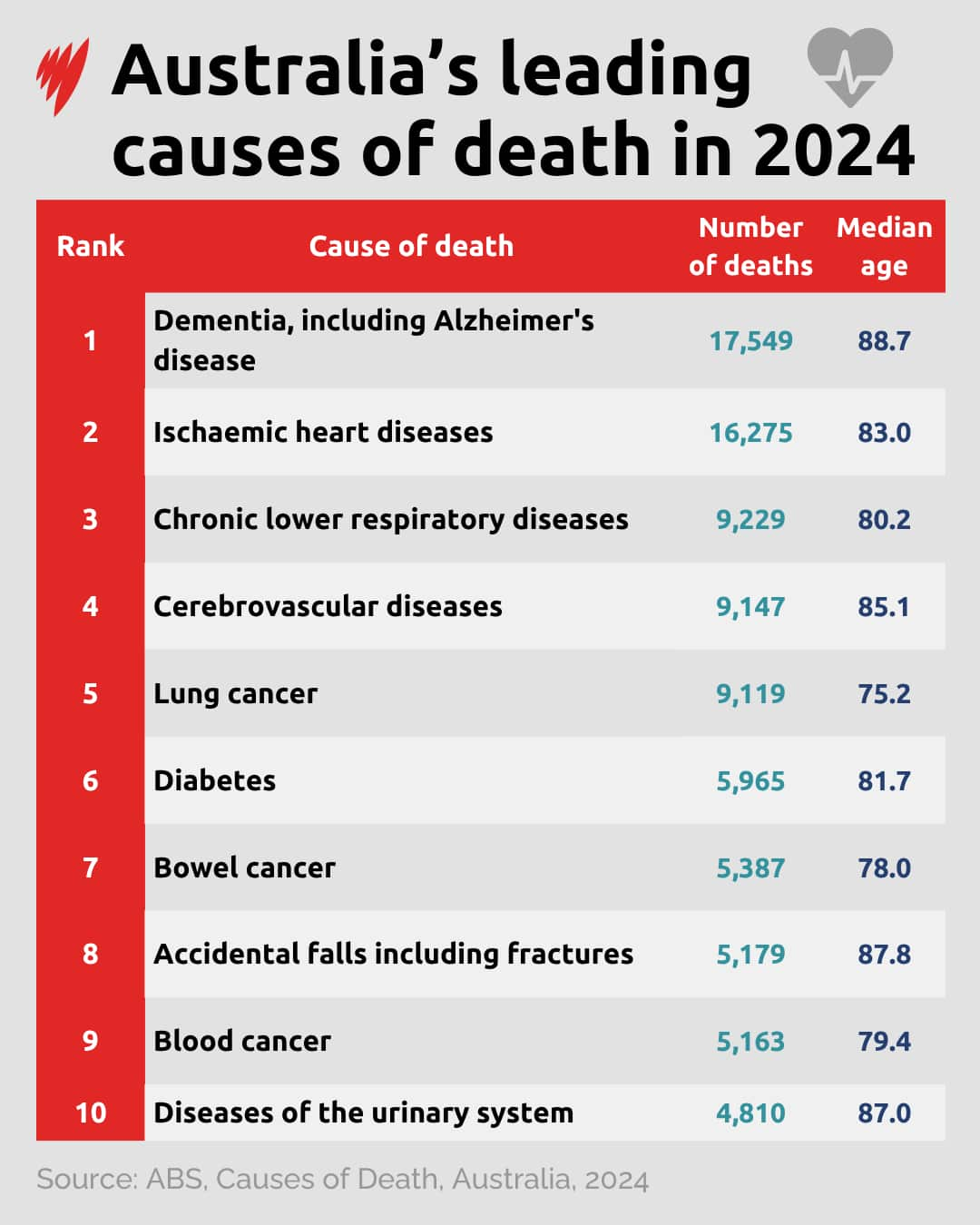This article references suicide and domestic violence.
Dementia has become the country's leading cause of death, according to the Australian Bureau of Statistics (ABS).
The ABS released new figures on Friday that revealed dementia, including Alzheimer's disease, accounted for more than 17,500 deaths (9.4 per cent) in Australia in 2024. The median age of death for those with dementia was 88.7 years old.
Dementia is an umbrella term for a group of symptoms caused by disorders affecting the brain. There are many forms, with the most common being Alzheimer's disease. Vascular dementia, related to blood flow to the brain, is also common.
The effects vary, but dementia generally affects memory, thinking, mood and behaviour. It is a progressive, degenerative, and terminal illness.
Dementia had long been the second-highest cause of death nationally behind ischaemic heart disease, with the two trading places in 2024.
Ischaemic heart disease, also known as coronary artery disease, is a condition in which the heart is damaged by narrow arteries, causing a reduced blood supply and a lack of oxygen.
There were 16,275 deaths from the disease in 2024, with the median age at death being 83 years. It remained the leading cause of death for men in Australia.
Chronic lower respiratory diseases were the third-highest cause of death in 2024, in front of cerebrovascular diseases and malignant neoplasms of trachea, bronchus and lung (lung cancer).
Only around 100 deaths separate the third and fifth spots, with the three conditions causing 9,229 deaths, 9,147 deaths and 9,119 deaths respectively.
Why are more people dying from dementia?
There has been a steady increase over the past decade in deaths caused by dementia. Between 2015 and 2024, the number of deaths in Australia due to dementia increased by nearly 39 per cent.
Lauren Moran, ABS' head of mortality statistics, said the leading causes of death in 2024 were in line with Australia's ageing population.

Source: SBS News
"People are now more likely to live to an age where they have a higher risk of developing dementia," Moran said.
"This is especially true for women who have longer life expectancies."
Dementia has been the leading cause of death for Australian women since 2016, and the ABS’ data showed more than 62 per cent of Australians who died from dementia in 2024 were women.
The ABS figures come after the Australian Institute of Health and Welfare (AIHW) said earlier this year that dementia had been the leading cause of death in 2023 — a year where the ABS found it to be ischaemic heart disease. Their counts differed because the AIHW included a small number of deaths from forms of dementia not featured in the ABS reporting.
The AIHW's Dementia in Australia report predicted that by 2065, more than one million Australians will be living with dementia — more than double the current number — as Australia's population grows and ages.
Professor Tanya Buchanan is the CEO of Dementia Australia, the country's peak body for those living with the condition.
She said that the figures reflect a need for more investment in public health approaches to brain health and dementia risk reduction, as well as more targeted support for people impacted by dementia.
"There are currently an estimated 433,300 Australians living with dementia, and without significant intervention, this number is expected to increase to more than one million by 2065," Buchanan said. "We need to act on dementia now."
Buchanan said that on a community level, there needed to be more awareness of dementia and brain health, to reduce the stigma experienced by those living with dementia.
"Across health, aged, disability and community care sectors, we need to ensure quality dementia care, with palliative care tailored to the needs of people living with dementia, their families and carers at the end of their life," she said.
"Although there are things we cannot change, like getting older or genetics, we now know that up to 45 per cent of dementia cases globally could be prevented or delayed by addressing modifiable risk factors."
What else did the data show about deaths in 2024?
There were 187,268 deaths registered in Australia in 2024, an increase of 4,137 deaths from 2023. The age-standardised mortality rate decreased to 507.8 deaths per 100,000 people, from 513 the previous year.
The ABS figures showed significant differences when comparing the causes of death in major cities to more remote areas.
While dementia was the leading cause of death in major cities and inner regional areas, it was ischaemic heart disease in outer regional, remote and very remote areas.
Suicide was the 16th highest cause of death overall and it was the sixth leading cause of death in remote and very remote areas. Diabetes was the sixth leading cause of death nationally, but the second-highest in very remote areas, and fifth-highest in remote Australia.
The leading cause of death for Aboriginal and Torres Strait Islander people in 2024 was ischaemic heart disease, followed by chronic lower respiratory diseases, diabetes, lung cancer and suicide.
Suicide was the leading cause of premature mortality (107,327 years of potential life lost), and the leading cause of death for people aged 15-44.
It was the 27th leading cause for females, and 16th leading cause of death in males, with men accounting for just over three-quarters of the 3,307 people who died by suicide in 2024.
The median age of death was 46 years. The Northern Territory had the highest suicide rate, followed by Queensland and Tasmania.
"Suicide is very complex and multifaceted," Moran said.
"Whilst it's extremely important to look at the demographic factors, we also acknowledge that for each individual things affect them in a different way, and different populations are also experiencing life stresses in different ways."
Moran said on average, around four risk factors were involved when someone took their life. Mood disorders such as depression were a leading risk factor, as well as suicidal ideation.
But there was significant variance in risk factors among different demographics.
Moran said while mood disorders such as depression were a much higher risk factor in younger age groups, limitation of activity due to disability was a much higher risk factor in those aged over 85.
Risk factors also presented differently for remote populations.
"For people living in remote and very remote Australia, alcohol intoxication, so a high alcohol level at death, was present in over 30 per cent of suicides, compared to close to 18 per cent for people living in major cities," Moran said.
Drug and alcohol-induced deaths both increased in 2024, with a preliminary count of 1,947 drug-induced deaths last year (up from 1,766 in 2023) and 1,765 alcohol-induced deaths (from 1,700).
"Acute toxicity was the main cause of drug-induced deaths. Opioids and other depressants, including benzodiazepines, were the most common drug class present," Moran said.
Moran said the proportion of deaths in which amphetamines were present in the body had increased, with psychostimulants such as methamphetamine and MDMA presenting in close to half of drug overdoses.
"We expect that number to go up," Moran said.
She added that acute toxicity — which was the main cause of drug-induced deaths overall — was one factor in deaths from amphetamine use, but there were often coinciding factors like cardiomyopathy.
Assaults also increased in 2024. There were 269 deaths due to assault in 2024, with 168 being male and 101 being female. Female deaths due to assault increased by 25 from 2023, and male deaths by four.
Moran said that for women who died by assault, the perpetrator was most likely to be a spouse or partner. Women were eight times more likely to die by assault from a perpetrator who was a spouse or partner.
Readers seeking crisis support can ring Lifeline on 13 11 14 or text 0477 13 11 14, the Suicide Call Back Service on 1300 659 467 and Kids Helpline on 1800 55 1800 (for young people aged up to 25). More information and support with mental health is available at beyondblue.org.au and on 1300 22 4636.
Embrace Multicultural Mental Health supports people from culturally and linguistically diverse backgrounds.
If you or someone you know is impacted by family and domestic violence, call 1800RESPECT on 1800 737 732, text 0458 737 732, or visit 1800RESPECT.org.au. In an emergency, call 000. The Men’s Referral Service, operated by No to Violence, can be contacted on 1300 766 491.
Share





